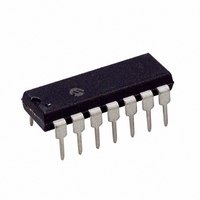PIC16F684-E/P Microchip Technology, PIC16F684-E/P Datasheet - Page 79

PIC16F684-E/P
Manufacturer Part Number
PIC16F684-E/P
Description
IC PIC MCU FLASH 2KX14 14DIP
Manufacturer
Microchip Technology
Series
PIC® 16Fr
Datasheets
1.PIC16F616T-ISL.pdf
(8 pages)
2.PIC16F688T-ISL.pdf
(688 pages)
3.PIC16F684-ISL.pdf
(4 pages)
4.PIC16F684-ISL.pdf
(192 pages)
5.PIC16F684-ISL.pdf
(6 pages)
6.PIC16F684-IST.pdf
(164 pages)
Specifications of PIC16F684-E/P
Program Memory Type
FLASH
Program Memory Size
3.5KB (2K x 14)
Package / Case
14-DIP (0.300", 7.62mm)
Core Processor
PIC
Core Size
8-Bit
Speed
20MHz
Peripherals
Brown-out Detect/Reset, POR, PWM, WDT
Number Of I /o
12
Eeprom Size
256 x 8
Ram Size
128 x 8
Voltage - Supply (vcc/vdd)
2 V ~ 5.5 V
Data Converters
A/D 8x10b
Oscillator Type
Internal
Operating Temperature
-40°C ~ 125°C
Processor Series
PIC16F
Core
PIC
Data Bus Width
8 bit
Data Ram Size
128 B
Maximum Clock Frequency
20 MHz
Number Of Programmable I/os
12
Number Of Timers
3
Operating Supply Voltage
2 V to 5.5 V
Maximum Operating Temperature
+ 125 C
Mounting Style
Through Hole
3rd Party Development Tools
52715-96, 52716-328, 52717-734
Development Tools By Supplier
PG164130, DV164035, DV244005, DV164005, PG164120, ICE2000, DM163014, DM164120-4
Minimum Operating Temperature
- 40 C
On-chip Adc
8-ch x 10-bit
Lead Free Status / RoHS Status
Lead free / RoHS Compliant
For Use With
DM163029 - BOARD PICDEM FOR MECHATRONICSACICE0207 - MPLABICE 14P 300 MIL ADAPTER
Connectivity
-
Lead Free Status / Rohs Status
Lead free / RoHS Compliant
10.2
To read a data memory location, the user must write the
address to the EEADR register and then set control bit
RD of the EECON1 register, as shown in Example 10-1.
The data is available, at the very next cycle, in the
EEDAT register. Therefore, it can be read in the next
instruction. EEDAT holds this value until another read, or
until it is written to by the user (during a write operation).
EXAMPLE 10-1:
10.3
To write an EEPROM data location, the user must first
write the address to the EEADR register and the data
to the EEDAT register. Then the user must follow a
specific sequence to initiate the write for each byte, as
shown in Example 10-2.
EXAMPLE 10-2:
The write will not initiate if the above sequence is not
exactly followed (write 55h to EECON2, write AAh to
EECON2, then set WR bit) for each byte. We strongly
recommend that interrupts be disabled during this
code segment. A cycle count is executed during the
required sequence. Any number that is not equal to the
required cycles to execute the required sequence will
prevent the data from being written into the EEPROM.
Additionally, the WREN bit in EECON1 must be set to
enable write. This mechanism prevents accidental
writes to data EEPROM due to errant (unexpected)
code execution (i.e., lost programs). The user should
keep the WREN bit clear at all times, except when
updating EEPROM. The WREN bit is not cleared
by hardware.
© 2007 Microchip Technology Inc.
BANKSEL
MOVLW
MOVWF
BSF
MOVF
BANKSEL
BSF
BCF
BTFSC
GOTO
MOVLW
MOVWF
MOVLW
MOVWF
BSF
BSF
Reading the EEPROM Data
Memory
Writing to the EEPROM Data
Memory
EECON1
EECON1,WREN ;Enable write
INTCON,GIE
INTCON,GIE
$-2
55h
EECON2
AAh
EECON2
EECON1,WR
INTCON,GIE
EEADR
CONFIG_ADDR ;
EEADR
EECON1,RD
EEDAT,W
DATA EEPROM READ
DATA EEPROM WRITE
;
;Disable INTs
;See AN576
;
;Unlock write
;
;
;
;Start the write
;Enable INTS
;
;Address to read
;EE Read
;Move data to W
After a write sequence has been initiated, clearing the
WREN bit will not affect this write cycle. The WR bit will
be inhibited from being set unless the WREN bit is set.
At the completion of the write cycle, the WR bit is
cleared in hardware and the EE Write Complete
Interrupt Flag bit (EEIF) is set. The user can either
enable this interrupt or poll this bit. The EEIF bit of the
PIR1 register must be cleared by software.
10.4
Depending on the application, good programming
practice may dictate that the value written to the data
EEPROM should be verified (see Example 10-3) to the
desired value to be written.
EXAMPLE 10-3:
10.4.1
The data EEPROM is a high-endurance, byte
addressable array that has been optimized for the
storage of frequently changing information (e.g.,
program variables or other data that are updated often).
When variables in one section change frequently, while
variables in another section do not change, it is possible
to exceed the total number of write cycles to the
EEPROM (specification D124) without exceeding the
total number of write cycles to a single byte
(specifications D120 and D120A). If this is the case,
then a refresh of the array must be performed. For this
reason, variables that change infrequently (such as
constants, IDs, calibration, etc.) should be stored in
Flash program memory.
BANKSELEEDAT
MOVF
BSF
XORWF
BTFSS
GOTO
:
Write Verify
USING THE DATA EEPROM
EEDAT,W
EECON1,RD
EEDAT,W
STATUS,Z
WRITE_ERR
WRITE VERIFY
PIC16F684
;
;EEDAT not changed
;from previous write
;YES, Read the
;value written
;Is data the same
;No, handle error
;Yes, continue
DS41202F-page 77














